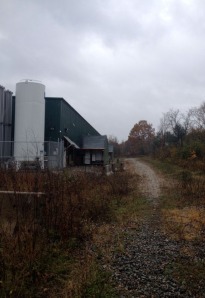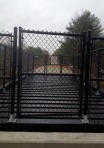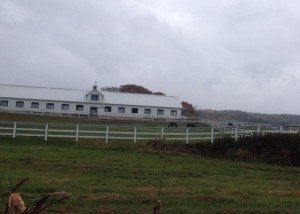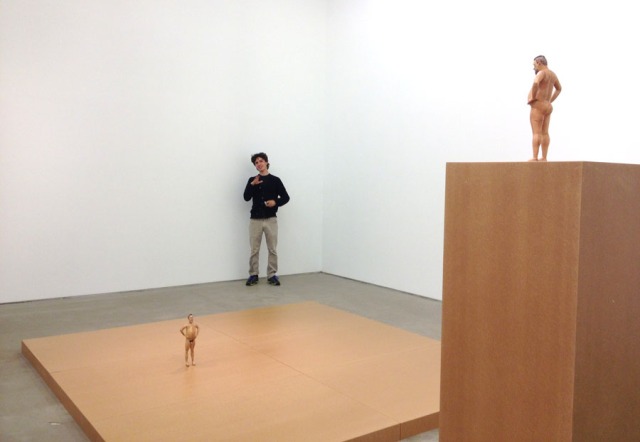I was due to arrive at a month-long residency at the Vermont Studio Center in late October, and I needed to complete the last leg of the Sebago Lake to Casco Bay run before my departure from Maine. My plan was to arrive at the residency with a complete line (the line created by running from Sebago Lake to Casco Bay with a gps watch). Time was running short, but the week before my departure, I decided to drive to New York to catch some exhibits and pick up my son, Link, who’d been on a bike trek from Washington D.C.
It turned out to be one of those New York trips where everything clicks. First, we caught the Jeff Koons’ show at the Whitney (the final weekend of the show and of the museum’s Madison Avenue location). Viewing the span of Koons’ work deepened my understanding of the artist, and though many of the individual objects still strike me as thin, I left the show thinking of the entire exhibit as a kind of critical engagement playground. There were some particularly enjoyable moments–the early basketball work, the tinted mirrors, and the huge pile of Play-Doh, among others–but viewing Koons’ work in a packed museum was what gave it life. Some viewers strutted around, decked out and oozing swagger; others nervously glanced from gallery to gallery, not sure where to let their eyes settle. Viewing Koons in public catches the viewer in a paradox of self conscious seduction, as if one doesn’t want to be seen enjoying the scale and glitter of banal objects too much. This feeling is amplified with the pornographic images. Viewers tended to cluster around the museum labels, not wanting to be seen enjoying, disliking, or being shocked by the posed intimacy between Koons and his ex-wife, Italian porn star and politician Cicciolina (Ilona Staller). Koons’ direct gaze amplifies the feeling of being seen watching, or being seen while avoiding looking too closely. That tension seemed an key component of the show.
 Chelsea was a pleasure this time around as well, with a surprise discovery of Brazilian artist, Efrain Almeida’s work, at CRG (image above). We were also able to catch Robert Gober’s retrospective, The Heart is Not a Metaphor, at MoMA. Gober was a wonderful counterpoint to Koons. With Gober, low-value materials were jam-packed with narrative and social critique. He had transformed wax, wallpaper, newspaper, suitcases, bathtubs, sinks, and even holes jackhammered into MoMA’s granite floors, leaving layers of meaning for the viewer to unpack. Gober’s Untitled (Candle), of 1991, would make for an interesting comparison with Koons.
Chelsea was a pleasure this time around as well, with a surprise discovery of Brazilian artist, Efrain Almeida’s work, at CRG (image above). We were also able to catch Robert Gober’s retrospective, The Heart is Not a Metaphor, at MoMA. Gober was a wonderful counterpoint to Koons. With Gober, low-value materials were jam-packed with narrative and social critique. He had transformed wax, wallpaper, newspaper, suitcases, bathtubs, sinks, and even holes jackhammered into MoMA’s granite floors, leaving layers of meaning for the viewer to unpack. Gober’s Untitled (Candle), of 1991, would make for an interesting comparison with Koons.
I was inspired. Link and I had jam-packed two days with feasting, family and friends, and art; now it was time to load up the bike, head back to Maine, and get back to work.
A few days later, after settling in at home, I set out on a cold and rainy afternoon to complete the final Presumpscot River run. Link agreed to come along so that I could make it a point-to-point rather than an out and back. I’d noted from a map that I might come across a closed section of the rail trail, but from a Google Maps satellite view, it looked like I’d be able to make my way through. I was optimistic.
I set out on an industrial stretch of trail; it wasn’t particularly lovely, but it looked passable. 

I was just settling into a groove when I came upon a fence–essentially a metal box over a bridge, which  made it impossible to cross over the road to the trail on the other side. The sign was menacing, and
made it impossible to cross over the road to the trail on the other side. The sign was menacing, and after a few minutes of deliberation, I decided not to scramble down to the road and up the other side; I’d reroute by the road.
after a few minutes of deliberation, I decided not to scramble down to the road and up the other side; I’d reroute by the road.
I began to make my way down a hill in the direction of the river. After a few strides, I ran into another sign, even more menacing.
 I crossed back over the trail and made my way through some wet, swampy grass to the road. At that point, I was drenched and cold. I had 5 miles to go, if everything went smoothly. I ran up over a ridge by Windham’s Maine Correctional Center, wondering if the prison explained the menacing signs. Over the hill, at the intersection with River Road, I glimpsed a long stretch of horse barn, one of the few scenic views of the run. With no sign of the Presumpscot, I took off down River Road, as cars
I crossed back over the trail and made my way through some wet, swampy grass to the road. At that point, I was drenched and cold. I had 5 miles to go, if everything went smoothly. I ran up over a ridge by Windham’s Maine Correctional Center, wondering if the prison explained the menacing signs. Over the hill, at the intersection with River Road, I glimpsed a long stretch of horse barn, one of the few scenic views of the run. With no sign of the Presumpscot, I took off down River Road, as cars  raced by over wet pavement. I spent the next 5 miles frequently jumping off the small shoulder as cars and trucks
raced by over wet pavement. I spent the next 5 miles frequently jumping off the small shoulder as cars and trucks  barreled by, apparently oblivious to my presence.
barreled by, apparently oblivious to my presence.
After a long 5+ miles, I reached Westbrook and realized I must have run by the entrance to the Community Center. I called Link, did a 180, and began to retrace my steps. I was wiped out, and when Link showed up a few minutes later, I gratefully climbed in the warm car where dry clothes were waiting for me.
I’d finished the Presumpscot River line–a significant part of my first watershed run. In Vermont, I’d be able to fill in the gaps in my growing installation of drawings and paintings.



Such an enjoyable blog, thank you. Reminds me why running is so incredible and much more than a calorie-burner.